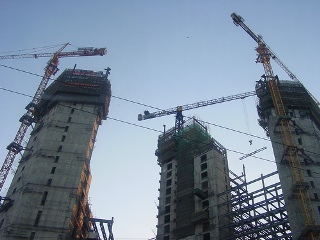 Global GDP is expected to expand by about 2.2 percent this year and strengthen to 3 percent and 3.3 percent in 2014 and 2015, as the world economy appears to be getting back on its feet, partly propped up by growth in developing countries.
Global GDP is expected to expand by about 2.2 percent this year and strengthen to 3 percent and 3.3 percent in 2014 and 2015, as the world economy appears to be getting back on its feet, partly propped up by growth in developing countries.
But developing countries need to implement reforms to sustain their fast growth, according to the World Bank’s latest Global Economic Prospects (GEP), issued this month.
“Growth in the developing world will remain solid, albeit slower than the frenetic growth rates seen during the pre-crisis boom period, as developing countries grapple with home-grown challenges brought on by capacity constraints in many middle-income countries,” the GEP said.
Developing-country GDP is now projected to be around 5.1 percent in 2013, strengthening to 5.6 percent and 5.7 percent in 2014 and 2015, respectively, with growth in Brazil, Russia, India and South Africa projected to remain weak. The East Asia and Pacific region is expected to grow by 7.3 percent this year; Europe and Central Asia by 2.8 percent; Latin America and the Caribbean by 3.3 percent; Middle East and North Africa by 2.5 percent; South Asia by 5.2 percent; and Sub-Saharan Africa by 4.9 percent.
Risks from advanced economies have receded, said the GEP. For high-income countries, growth this year will be a modest 1.2 percent, firming to 2 percent in 2014 and 2.3 percent by 2015. Euro area growth is expected to be a modest 0.9 percent in 2014 and 1.5 percent in 2015.
Global trade, after contracting for several months, is expanding once again, but only by 4 percent in 2013, well off the pre-crisis pace of 7.3 percent. Global commerce is partly boosted by the rapid expansion in South-South trade. More than 50 percent of developing country exports now go to other developing countries. Even when China is excluded, South-South trade has been growing at an average rate of 17.5 percent a year over the past decade, with manufacturing trade expanding as rapidly as commodities trade, the report said,
Growth in the East Asia and the Pacific region was robust in the first quarter of 2013, but slower than last year. Overall, the regional economy is projected to expand by around 7.3 percent in 2013, before accelerating to 7.5 percent in 2014 and 2015. The weakness in 2013 partly reflects weak 7.7 percent growth in China, which is expected to strengthen to 8 and 7.9 percent in 2014 and 2015 respectively.
Regional growth, excluding China, will slow in 2013 to 5.7 percent, partly due to fiscal policy tightening, but then firm on solid growth in Indonesia, Malaysia, Philippines, and Thailand. Risks to the region include those surrounding the gradual reduction in Chinese investment, Japanese quantitative easing, rapidly expanding credit, and rising asset prices.
After slowing sharply in 2012, GDP growth in Europe and Central Asia in 2013 is expected to reach 2.8 percent in 2013 and 4.2 percent by 2015.
Growth in Latin America and the Caribbean is expected to strengthen marginally to 3.3 percent in 2013, from 3 percent in 2012. Over the medium term, the regional economy is expected to grow just under 4 percent annually.
Growth in the Middle East & North Africa region is projected to slow to 2.5 percent in 2013, from 3.5 percent in 2012. Regional GDP growth is projected at 3.5 percent in 2014 and 4.2 percent in 2015.
GDP growth in South Asia slipped to 4.8 percent in 2012, mainly reflecting a continued deceleration in India, slower growth in Sri Lanka and Bangladesh, and sluggish growth in Pakistan and Nepal. Regional GDP growth is projected to pick up to 5.2 percent in 2013, before accelerating to 6 percent and 6.4 percent in 2014 and 2015.
Sub-Saharan Africa is expected to have GDP growth over the 2013-2015 period of about 5.2 percent.
Photo: kalmyket




